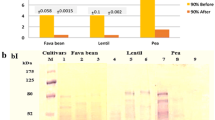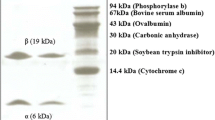Abstract
A lectin has successfully been isolated from Phaseolus vulgaris cv. Chinese pinto bean using affinity chromatography, ion exchange chromatography, and gel filtration in succession, with a 15.4-fold purification. Investigation of its characteristics revealed that Chinese pinto bean lectin (CPBL) was a 58-kDa dimeric glucosamine-binding protein. Its Mg2+-dependent hemagglutinating activity was stable at pH 7–8 and at or below 60 °C. When the purified lectin was tested against six fungal species including Phyllosticta citriasiana, Magnaporthe grisea, Bipolans maydis, Valsa mali, Mycosphaerella arachidicola, and Setosphaeria turcica, only the mycelial growth of V. mali was reduced by 30.6 % by the lectin at 30 μM. The lectin did not exert any discernible antiproliferative effects on breast cancer MCF-7 cells, but was able to suppress proliferation of nasopharyngeal carcinoma HONE-1 cells, with an IC50 of 17.3 μM, as revealed by the MTT assay. Since few plant lectins demonstrate antifungal activity against V. mali, and not many others have inhibitory effects on HONE-1 cells, CPBL is a distinctive lectin which may be exploited for development into an agent against V. mali and HONE-1 cells.





Similar content being viewed by others
References
Liu, B., Bian, H. J., & Bao, J. K. (2010). Plant lectins: potential antineoplastic drugs from bench to clinic. Cancer Letters, 287(1), 1–12.
Liener, I. E., Sharon, N., & Goldstein, I. J. (1986). The lectins: properties, functions and applications in biology and medicine. Orlando: Academic.
Sumner, J. B., & Howell, S. F. (1936). Identification of hemagglutinin of jack bean with concanavalin A. Journal of Bacteriology, 32(2), 227–237.
Lam, S. K., & Ng, T. B. (2011). Lectins: production and practical applications. Applied Microbiology and Biotechnology, 89(1), 45–55.
Yan, Q., Jiang, Z., Yang, S., Deng, W., & Han, L. (2005). A novel homodimeric lectin from Astragalus mongholicus with antifungal activity. Archives of Biochemistry and Biophysics, 442, 72–81.
Bhat, G. G., Shetty, K. N., Nagre, N. N., Neekhra, V. V., Lingaraju, S., Bhat, R. S., Inamdar, S. R., Suguna, K., & Swamy, B. M. (2010). Purification, characterization and molecular cloning of a monocot mannose-binding lectin from Remusatia vivipara with nematicidal activity. Glycoconjugate Journal, 27, 309–320.
Lam, S. K., & Ng, T. B. (2009). Novel galactonic acid-binding hexameric lectin from Hibiscus mutabilis seeds with antiproliferative and potent HIV-1 reverse transcriptase inhibitory activities. Acta Biochimica Polonica, 56, 649–654.
Chan, Y. S., Wong, J. H., Fang, E. F., Pan, W., & Ng, T. B. (2012). Isolation of a glucosamine binding leguminous lectin with mitogenic activity towards splenocytes and anti-proliferative activity towards tumor cells. PLoS One, 7(6).
Chan, Y. S., Wong, J. H., Fang, E. F., Pan, W., & Ng, T. B. (2013). A hemagglutinin from northeast red beans with immunomodulatory activity and anti-proliferative and apoptosis-inducing activities toward tumor cells. Protein and Peptide Letters, 20, 1159–69.
Fang, E. F., Pan, W. L., Wong, J. H., Chan, Y. S., Ye, X. J., & Ng, T. B. (2011). A new Phaseolus vulgaris lectin induces selective toxicity on human liver carcinoma Hep G2 cells. Archives of toxicology, 85, 1551–63.
Lam, S. K., & Ng, T. B. (2010). Isolation and characterization of a French bean hemagglutinin with antitumor, antifungal, and anti-HIV-1 reverse transcriptase activities and an exceptionally high yield. Phytomedicine, 17, 457–62.
Wong, J. H., Wan, C. T., & Ng, T. B. (2010). Characterisation of a haemagglutinin from Hokkaido red bean (Phaseolus vulgaris cv. Hokkaido red bean). Journal of the Science of Food and Agriculture, 90, 70–77.
Fang, E. F., Lin, P., Wong, J. H., Tsao, S. W., & Ng, T. B. (2010). A lectin with anti-HIV-1 reverse transcriptase, antitumor, and nitric oxide inducing activities from seeds of Phaseolus vulgaris cv. extralong autumn purple bean. Journal of Agricultural and Food Chemistry, 58, 2221–2229.
Sharma, A., Ng, T. B., Wong, J. H., & Lin, P. (2009). Purification and characterization of a lectin from Phaseolus vulgaris cv. (Anasazi beans). Journal of Biomedicine and Biotechnology, 2009, 929568.
Cheung, R. C., Leung, H. H., Pan, W. L., & Ng, T. B. (2013). A calcium ion-dependent dimeric bean lectin with antiproliferative activity toward human breast cancer MCF-7 cells. Protein Journal, 32, 208–15.
Lyu, S. Y., Choi, S. H., & Park, W. B. (2002). Korean mistletoe lectin-induced apoptosis in hepatocarcinoma cells is associated with inhibition of telomerase via mitochondrial controlled pathway independent of p53. Archives of Pharmacal Research, 25, 93–101.
Plattner, V. E., Wagner, M., Ratzinger, G., Gabor, F., & Wirth, M. (2008). Targeted drug delivery: binding and uptake of plant lectins using human 5637 bladder cancer cells. European Journal of Pharmaceutics and Biopharmaceutics, 70, 572–576.
Lei, H. Y., & Chang, C. P. (2007). Induction of autophagy by concanavalin A and its application in anti-tumour therapy. Autophagy, 3, 402–404.
Liu, B., Cheng, Y., Bian, H. J., & Bao, J. K. (2009). Molecular mechanisms of Polygonatum cyrtonema lectin induced apoptosis and autophagy in cancer cells. Autophagy, 5, 253–255.
Sa, Q., Wang, Y., Li, W., Zhang, L., & Sun, Y. (2003). The promoter of an antifungal protein gene from Gastrodia elata confers tissue-specific and fungus-inducible expression patterns and responds to both salicylic acid and jasmonic acid. Plant Cell Reports, 22(1), 79–84.
Does, M. P., Houterman, P. M., Dekker, H. L., & Cornelissen, B. J. (1999). Processing, targeting, and antifungal activity of stinging nettle agglutinin in transgenic tobacco. Plant Physiology, 120, 421–432.
Van Parijs, J., Broekaert, W. F., Goldstein, I. J., & Peumans, W. J. (1991). Hevein: an antifungal protein from rubber-tree (Hevea brasiliensis) latex. Planta, 183, 258–264.
Broekaert, W. F., Mariën, W., Terras, F. R., De Bolle, M. F., Proost, P., Van Damme, J., Dillen, L., Claeys, M., Rees, S. B., & Vanderleyden, J. (1992). Antimicrobial peptides from Amaranthus caudatus seeds with sequence homology to the cysteine/glycine-rich domain of chitin-binding proteins. Biochemistry, 31, 4308–4314.
Karasaki, Y., Tsukamoto, S., Mizusaki, K., Sugiura, T., & Gotoh, S. (2001). A garlic lectin exerted an antitumor activity and induced apoptosis in human tumor cells. Food Research International, 34, 7–13.
Ng, T. B., Ngai, P. H., & Xia, L. (2006). An agglutinin with mitogenic and antiproliferative activities from the mushroom Flammulina velutipes. Mycologia, 98, 167–171.
Pajic, I., Kljajic, Z., Dogovic, N., Sladic, D., Juranic, Z., & Gasic, M. J. (2002). A novel lectin from the sponge Haliclona cratera: isolation, characterization and biological activity. Comparative Biochemistry Physiology C Toxicology Pharmacology, 132, 213–221.
Xia, L., & Ng, T. B. (2005). An antifungal protein from flageolet beans. Peptides, 26, 2397–2403.
Lin, P., Ye, X., & Ng, T. B. (2008). Purification of melibiose-binding lectins from two cultivars of Chinese black soybeans. Acta Biochim Biophys Sin (Shanghai), 40, 1029–1038.
Cheung, A. H., Wong, J. H., & Ng, T. B. (2009). Musa acuminata (Del Monte banana) lectin is a fructose-binding lectin with cytokine-inducing activity. Phytomedicine, 16, 594–600.
Wong, J. H., & Ng, T. B. (2005). Isolation and characterization of a glucose/mannose/rhamnose-specific lectin from the knife bean Canavalia gladiate. Archives of Biochemistry and Biophysics, 439, 91–98.
Franz, H., Ziska, P., & Kindt, A. (1981). Isolation and properties of three lectins from mistletoe (Viscum album L.). The Biochemical journal, 195, 481–4.
Rostock, M., Huber, R., Greiner, T., Fritz, P., Scheer, R., Schueler, J., & Fiebig, H. H. (2005). Anticancer activity of a lectin-rich mistletoe extract injected intratumorally into human pancreatic cancer xenografts. Anticancer Research, 25, 1969–75.
Bantel, H., Engels, I. H., Voelter, W., Schulze-Osthoff, K., & Wesselborg, S. (1999). Mistletoe lectin activates caspase-8/FLICE independently of death receptor signaling and enhances anticancer drug-induced apoptosis. Cancer research, 59, 2083–90.
Lyu, S. Y., Kwon, Y. J., Joo, H. J., & Park, W. B. (2004). Preparation of alginate/chitosan microcapsules and enteric coated granules of mistletoe lectin. Archives of Pharmacal Research, 27, 118–126.
Wong, J. H., Wong, C. C., & Ng, T. B. (2006). Purification and characterization of a galactose-specific lectin with mitogenic activity from pinto beans. Biochimica et Biophysica Acta, 1760(5), 808–13.
Matsumoto, I., & Osawa, T. (1972). The specific purification of various carbohydrate-binding hemagglutinins. Biochemical and Biophysical Research Communications, 46(5), 1810–5.
Sela, B. A., Lis, H., Sharon, N., & Sachs, L. (1973). Isolectins from wax bean with differential agglutination of normal and transformed mammalian cells. Biochimica et Biophysica Acta, 310(1), 273–7.
Kamemura, K., Furuichi, Y., Umekawa, H., & Takahashi, T. (1993). Purification and characterization of novel lectins from Great Northern bean, Phaseolus vulgaris L. Biochimica et Biophysica Acta, 1158(2), 181–8.
Ye, X. Y., Ng, T. B., Tsang, P. W., & Wang, J. (2001). Isolation of a homodimeric lectin with antifungal and antiviral activities from red kidney bean (Phaseolus vulgaris) seeds. Journal of Protein Chemistry, 20(5), 367–75.
Neth, O., Jack, D. L., Dodds, A. W., Holzel, H., Klein, N. J., & Turner, M. W. (2000). Mannose-binding lectin binds to a range of clinically relevant microorganisms and promotes complement deposition. Infection and Immunity, 68, 688–693.
Persson, A., Chang, D., & Crouch, E. (1990). Surfactant protein D is a divalent cation-dependent carbohydrate-binding protein. Journal of Biological Chemistry, 265, 5755–5760.
Devi, S. K., Singh, S. S., Singh, S. J., Rully, H., & Singh, L. R. (2011). Purification and characterization of a magnesium ion requiring N-acetyl-d-glucosamine specific lectin from seeds of Quercus ilex L. Bioscience, Biotechnology, and Biochemistry, 75(9), 1752–7.
Balzarini, J., Neyts, J., Schols, D., Hosoya, M., Van Damme, E., Peumans, W., & De Clercq, E. (1992). The mannose-specific plant lectins from Cymbidium hybrid and Epipactis helleborine and the (N-acetylglucosamine)n-specific plant lectin from Urtica dioica are potent and selective inhibitors of human immunodeficiency virus and cytomegalovirus replication in vitro. Antiviral Research, 18(2), 191–207.
Sharon, N., & Lis, H. (1972). Lectins: cell-agglutinating and sugar-specific proteins. Science, 177(4053), 949–59.
Lin, P., & Ng, T. B. (2008). Preparation and biological properties of a melibiose binding lectin from Bauhinia variegata seeds. Journal of Agricultural and Food Chemistry, 56(22), 10481–6.
Wong, J. H., & Ng, T. B. (2005). Vulgarinin, a broad-spectrum antifungal peptide from haricot beans (Phaseolus vulgaris). International Journal of Biochemistry and Cell Biology, 37(8), 1626–32.
Zhang, G., Sun, J., Wang, H., & Ng, T. B. (2010). First isolation and characterization of a novel lectin with potent antitumor activity from a Russula mushroom. Phytomedicine, 17(10), 775–81.
Wang, H. X., Ng, T. B., & Ooi, V. E. C. (1998). Lectins from mushrooms. Mycological Research, 102, 897–906.
Bohlool, B. B., & Schmidt, E. L. (1974). Lectins: a possible basis for specificity in the rhizobium-legume root nodule symbiosis. Science, 185(4147), 269–71.
Andrade, C. A., Correia, M. T., Coelho, L. C., Nascimento, S. C., & Santos-Magalhães, N. S. (2004). Antitumor activity of Cratylia mollis lectin encapsulated into liposomes. International Journal of Pharmaceutics, 278, 435–445.
Author information
Authors and Affiliations
Corresponding authors
Rights and permissions
About this article
Cite this article
Ang, A.S.W., Cheung, R.C.F., Dan, X. et al. Purification and Characterization of a Glucosamine-Binding Antifungal Lectin from Phaseolus vulgaris cv. Chinese Pinto Beans with Antiproliferative Activity Towards Nasopharyngeal Carcinoma Cells. Appl Biochem Biotechnol 172, 672–686 (2014). https://doi.org/10.1007/s12010-013-0542-2
Received:
Accepted:
Published:
Issue Date:
DOI: https://doi.org/10.1007/s12010-013-0542-2




